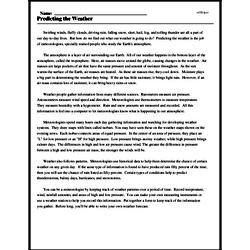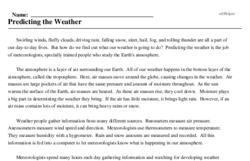Predicting the Weather
National Weatherperson Day
Reading Comprehension for February 5
Swirling winds, fluffy clouds, driving rain, falling snow, sleet, hail, fog, and rolling thunder are all a part of our day-to-day lives. But how do we find out what our weather is going to do? Predicting the weather is the job of meteorologists, specially trained people who study the Earth's atmosphere.
The atmosphere is a layer of air surrounding our Earth. All of our weather happens in the bottom layer of the atmosphere, called the troposphere. Here, air masses move around the globe, causing changes in the weather. Air masses are large pockets of air that have the same pressure and amount of moisture throughout. As the sun warms the surface of the Earth, air masses are heated. As these air masses rise, they cool down. Moisture plays a big part in determining the weather they bring. If the air has little moisture, it brings light rain. However, if an air mass contains lots of moisture, it can bring heavy rains or snow.
Weather people gather information from many different sources. Barometers measure air pressure. Anemometers measure wind speed and direction. Meteorologists use thermometers to measure temperature. They measure humidity with a hygrometer. Rain and snow amounts are measured and recorded. All this information is fed into a computer to let meteorologists know what is happening in our atmosphere.




